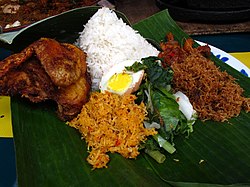Nasi ambeng or nasi ambang is an Indonesian fragrant rice dish that consists of—but is not limited to[2]—steamed white rice, chicken curry or chicken stewed in soy sauce, beef or chicken rendang, sambal goreng (lit. fried sambal; a mildly spicy stir-fried relish commonly made with firm tofu, tempeh, and long beans[3]) urap, bergedel, and serunding.
 A serving of nasi ambeng | |
| Course | Main course |
|---|---|
| Place of origin | Indonesia[1] |
| Region or state | Java |
| Associated cuisine | Indonesia, Malaysia, and Singapore |
| Created by | Javanese |
| Main ingredients | Steamed rice, fried tempeh, bergedel, rempeyek, rendang, sambal goreng, boiled egg, urap and sometimes fried noodles (Selangor region) |
It is a popular food in Javanese cuisine, especially within the Javanese-Malay communities[4] in Singapore[5] and the Malaysian states of Johor and Selangor where they also added fried noodles as additional condiments.[6][7]
Nasi ambeng is often served communal dining-style on a platter[8] to be shared among four to five people, especially during festive or special occasions such as a kenduri.[9]
See also
editReferences
edit- ^ Zieman (24 August 2010). "Communal dish". The Star.
- ^ "Communal Dish". The Star Online, Malaysia. Retrieved 2018-05-03.
- ^ Shameer, Shana. "Sambal Goreng Tahu Tempe (Bean Curd, Tempe and Long Beans)". Retrieved 2018-05-03.
- ^ Dil, Munsyi. "Nasi Ambeng". Retrieved 2018-05-03.
- ^ Goh, Kenneth. "Yummy platter". The Straits Times, Singapore. Retrieved 2018-05-03.
- ^ "WARUNG IBU NASI AMBENG, KUALA SELANGOR". Escapy Travel Mag.
- ^ Zieman (24 August 2010). "Communal dish". The Star.
- ^ Goh, Kenneth. "Yummy platter". The Straits Times, Singapore. Retrieved 2018-05-03.
- ^ Hirdan, Kusyi. "Simbolik daripada nasi ambeng". Harian Metro, Malaysia. Retrieved 2018-05-03.